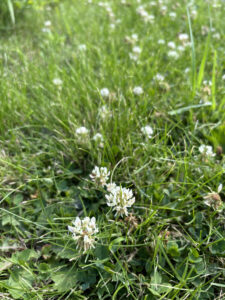
Mowers pass over low-growing clovers.
We recently discovered an amusing irony created by one of the most common lawn plants – white clover.
Sometimes called Dutch Clover, this low-growing plant graces unsprayed lawns in temperate regions across the globe. Normally, we discourage nonnative plants at Winding Pathways, but clover is an exception.
Although native to Eurasia, it’s not invasive. This important forage legume is likely the most widespread in the world. Diminutive clover is so low growing our mower passes right over its dainty flowers. Our friendly cottontail bunnies may seem to be eating grass, but actually, they’re feasting on clover. So are beneficial insects. As its flowers add beauty to the lawn and feed animals, clover’s roots pump nitrogen into the soil, helping other plants grow.
The irony
AI detected our Internet search for clover information. We began getting computer ads from landscaping companies encouraging us to hire them to kill our clover “and other weeds” in our lawn. No way!
Many people spend good money to poison beneficial lawn plants. They expose themselves, their pets, and anyone who walks on the lawn to toxic substances.
Maintaining a Healthy Bed of White Clover
White clover tends to gradually decline over the years. We’ve noticed this at Winding Pathways. To give it a boost we buy white clover seeds and sprinkle them on the lawn during cool months, especially on bare spots. Seed can be purchased online and in stores where hunters shop. These stores sell seeds beneficial to wildlife, and hunters often plant them to boost food for deer and wild turkeys.
- Clover can be manicured.
- Sunlight on a clover lawn forms a cross.
- Dutch White Clover is low-growing.
Rewards
We have healthy lawns, rich with nitrogen. And, on summer mornings and evenings, we sit in our front porch’s rocking chairs watching bumble bees and bunnies foraging on our blooming white clovers. Thanks, clover.
- Bunnies enjoy clover.
- Watchful

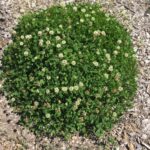
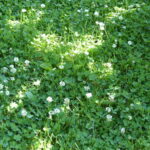
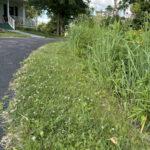
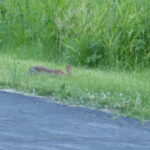
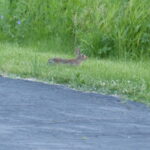

The rabbits and deer might eat white clover, but our sheep and the woodchucks that used to live in our pasture won’t eat it. They gobble up red clover, which needs refreshing every few years. Once the red clover was gone, the woodchucks disappeared. I plan to reseed the pastures next winter with red clover to try to bring it back. Right now, Kentucky bluegrass is thriving, along with some orchard grass. the sheep much prefer the orchard grass, so we are moving them every few days and mowing the bluegrass behind them to keep it from heading out. This year’s abundant rain has made this all very challenging, but at least it’s been better than last year’s drought!
Dan, this is a fascinating description of the plants, how you manage, and comment on drought and plentiful rain. thanks! M~